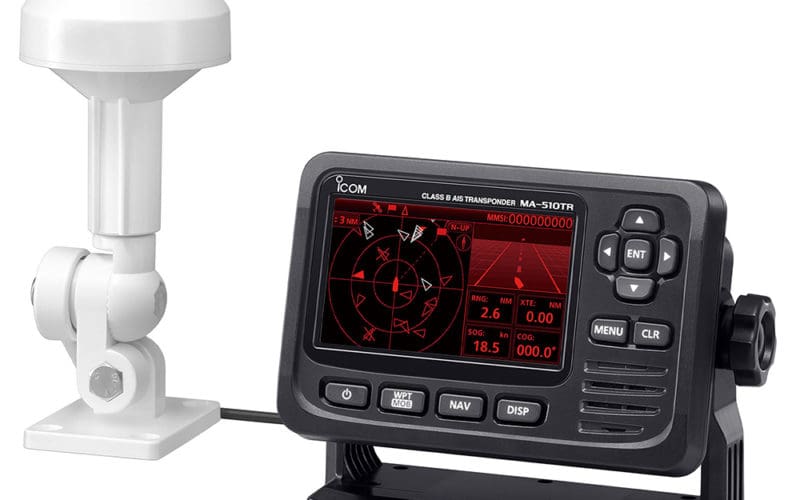
A stand-alone AIS transceiver is a must for both coastal and offshore sailing craft, especially around large harbors with lots of ship traffic and sometimes dense fog. AIS-equipped VHF radios are generally limited to receiving AIS transmissions and displaying them either on a small screen or a separate chartplotter.
To alert another vessel, the operator can either call by VHF radio or activate the DSC (digital select calling) function, which transmits the vessel’s name and position with the vessel’s Maritime Mobile Service Identities code.
The advantage of a self-contained AIS transceiver is obvious: Every AIS-equipped vessel in your area is constantly aware of your position, averting the need to make voice radio contact. If you are single-handed and sitting at the helm steering through dense fog, you need to know your AIS transceiver has your back.
The SI-TEX SAS-600 is a highly sophisticated, fully certified five-watt Class B AIS transceiver possessing the same network capabilities as Commercial Class A AIS units. Though this model, with its impressive, 5.7-inch full-color LCD display, is intended for commercial vessels, it is also a great choice for cruising vessels.
With input voltage of 12-24 volts DC and current draw of less than 12 watts, a mid-size yacht with an 8D house battery and a healthy charging system should have no trouble keeping up with the SI-TEX’s amperage draw.
This sophisticated AIS system uses full-color C-Map Max cartography, which can serve as a back-up to your main chartplotter. A built-in GPS and GLONASS satellite navigation receiver helps to keep you on track while staying in touch with other vessels in your area.
The SI-TEX SAS-600 may be installed on a dedicated pedestal or flush-mounted to the nav pod in the cockpit. The unit is rated IPX6 and IPX7 waterproof. At roughly $1,300, this device is at the top of its class and the choice of many commercial vessels as well as cruising craft.
A model that claims to be the world’s best-selling commercial grade Class A AIS model is the Em-Trak A100, measuring 8.2 inches wide by 4.1 inches high by 5.4 inches deep, not exactly diminutive yet still of manageable dimensions for the medium-size to larger yacht.
The A100 transceiver features a grayscale display, NMEA 0183 communication, and a GPS antenna with 33 feet of cable. The A100’s plug-and-play connectivity permits easy networking with other electronics in your nav station.
Em-Trak’s rugged AIS transceiver is easy to install and easy to use and has demonstrated a record of proven reliability on both commercial and pleasure craft. With a rating of IP52, the A100 is best installed belowdecks, although it can stand up to a good dose of dust and ocean spray. With a price tag of roughly $1,200, this model certainly offers a lot for the modest investment.
Another high-quality, yet more affordable AIS model is the ICOM MA510TR AIS transponder with GPS antenna. This Class B device is capable of receiving both A and B AIS signals, a feature allowing a broader range of detection and enhanced safety.
Featuring NMEA 2000, NMEA 0183 and USB connectivity, the ICOM MA510TR can talk to virtually any other electronic device on your vessel, such as a chartplotter, radar, VHF radio or external GPS.
With its IPX7 rating, this waterproof ICOM transponder can be installed in the cockpit with the GPS chartplotter and VHF radio for maximum safety while navigating through a crowded seaway. This unit also features a man-overboard (MOB) signal, a collision alarm and an anchor watch alarm, which is activated when the vessel is adrift at anchor. Available online for roughly $900, the ICOM MA510TR AIS offers top quality from a name we trust.
While the preferred approach is to have a stand-alone AIS that both receives and transmits, for smaller vessels with a tighter budget and a general philosophy of “stay out of the way” it’s better than nothing to have a receive-only AIS to keep track of the bigger guys. One cost effective way to do this is to go with a “black box” AIS receive-only unit like the Furuno FA-40. This AIS receiver has no display of its own but can be connected to a compatible chartplotter or a radar unit and will provide AIS data on that unit’s screen. It can be interfaced using either its single NMEA 2000 port or two NMEA 0183 ports. The FA-40 is available for $675.
A big part of safety in any seaway in today’s cruising environment is not only knowing where we are, but also knowing where others are on the water. Installing a high-quality, stand-alone AIS transceiver is one big way of ensuring our safety in an ever-more-crowded cruising aquasphere.
Circumnavigator-author Bill Morris believes the best strategy for succeeding as an offshore voyager is to keep systems simple and, if possible, manual. Key to survival are a windvane self-steering system, a basic array of electronics and an aggressive alternative energy battery charging matrix. Bill is a frequent contributor to Ocean Navigator and the author of The Windvane Self-Steering Handbook (International Marine, 2004) and The Captain’s Guide to Alternative Energy Afloat (Seaworthy Publications, 2019).

